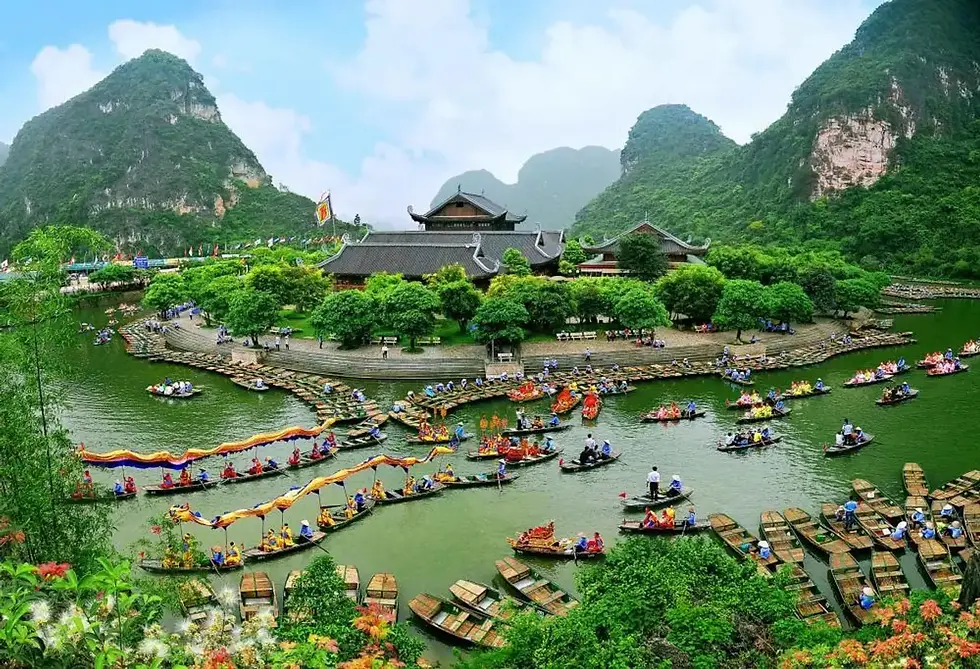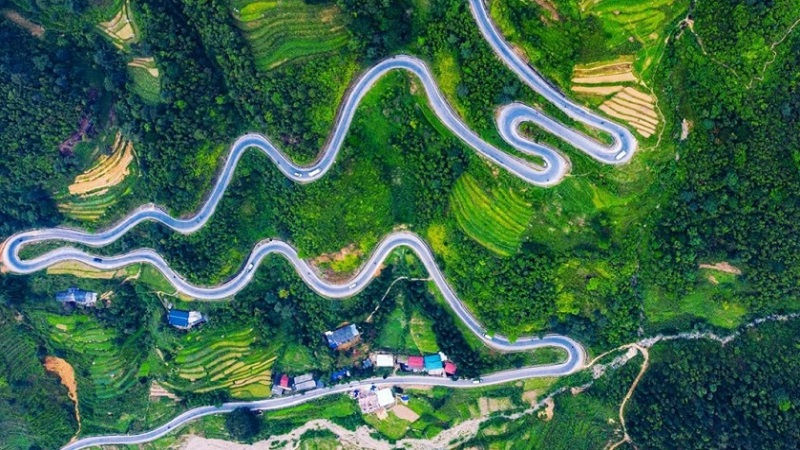Top 5 must - visit places in Northern Vietnam for first-time travelers
- ISEN TRAVEL
- Jul 29
- 6 min read
Northern Vietnam is where the soul of the country lies - a region steeped in history, rich culture, and breathtaking natural beauty. From ancient temples and colonial architecture to limestone mountains, terraced rice fields, and winding highland passes, this part of Vietnam offers an unforgettable journey for travelers of all kinds.
For first-time visitors, Northern Vietnam is the perfect starting point to experience the country’s unique blend of tradition and modernity. Whether you're exploring the bustling streets of Hanoi, sailing through the emerald waters of Halong Bay, or trekking among the misty mountains of Sapa, each destination has its own story to tell. In this blog, we’ll take you through 5 of the most essential places to visit in Northern Vietnam, with tips on what to see, where to eat, and how to make the most of your journey.
1.Hanoi - The capital city of Vietnam
Nestled in the heart of Northern Vietnam, Hanoi is a captivating blend of old-world charm and modern energy. As the country’s capital, it serves as a living museum of Vietnamese history, culture, and resilience. Wandering through its bustling Old Quarter, visitors are transported back in time by the maze of narrow streets, traditional shop-houses, and lively street markets. Tranquil spots like Hoan Kiem Lake and Ngoc Son Temple offer a peaceful contrast to the city's vibrant pace, while cultural landmarks such as the Temple of Literature, Ho Chi Minh Mausoleum, and the Thang Long Imperial Citadel give insight into Vietnam's rich heritage.

No trip to Hanoi is complete without exploring its iconic street food scene. Start your day with a bowl of steaming hot pho bo (beef noodle soup), enjoy a plate of savory bun cha (grilled pork with noodles and herbs) for lunch, and don’t forget to try cha ca la vong (turmeric grilled fish with dill) - a dish unique to the capital. For dessert or a midday break, sip on the famous egg coffee (ca phe trung) at a hidden café overlooking the rooftops.

Whether you're watching a water puppet show at the Thang Long Theater or enjoying the view from a rooftop bar in the French Quarter, Hanoi promises a rich and unforgettable culture experience for first-time travelers.
2.Ha Long Bay - A breathtaking natural wonder
Ha Long Bay was recognized by UNESCO as a World’s Natural Heritage Site and located in Quang Ninh Province. Ha Long Bay is limited to an area of 1,553 km2. It includes 1,969 large and small islands, mainly limestone islands. In particular, the core of the bay is where about 775 islands are densely packed together, creating an extremely vivid natural picture. With a total of 1,969 large and small islands in Ha Long Bay, only about 40 islands are inhabited. The population is mainly concentrated in fishing villages such as Cua Dai, Ba Hang, and Cap De.
The area with many beautiful rocky islands and caves in Ha Long Bay is the core area (center of Ha Long Bay), Lan Ha Bay of Cat Ba archipelago and part of Bai Tu Long Bay. Each island in Ha Long Bay has its own shape such as: Fighting Chicken Island, Dog Stone Island, Dinh Huong Island, La Vong Island, etc. Some famous caves in Ha Long Bay include: Sung Sot Cave, Thien Cung Cave, Dau Go Cave, etc. Thanks to the conditions and advantages bestowed by nature, Ha Long Bay has become one of the attractive tourist destinations for domestic and foreign tourists.

3.Ninh Binh - The Ha Long Bay on land
Often dubbed the “Halong Bay on land,” Ninh Binh is a tranquil escape from the busy streets of Hanoi, offering visitors a stunning mix of limestone mountains, winding rivers, ancient temples, and peaceful countryside. Just a two-hour drive south of the capital, Ninh Binh surprises travelers with its dramatic karst landscapes, lush rice paddies, and rich cultural heritage. One of the top experiences in Ninh Binh is taking a boat ride in Trang An or Tam Coc, where you’ll float gently through cave tunnels and between towering limestone cliffs reflected in emerald waters. Do not miss a hike to the top of Hang Mua (Mua Cave) — the panoramic view of the valley below is absolutely worth the climb.

In recognition of its outstanding natural beauty and cultural value, the Trang An Landscape Complex was designated a UNESCO World Heritage Site in 2014, making it Vietnam’s first mixed cultural and natural heritage site. The area is home to both breathtaking scenery and ancient archaeological sites dating back thousands of years. Ninh Binh also boasts Bai Dinh Pagoda, the largest Buddhist complex in Vietnam, and the ancient capital of Hoa Lu, where visitors can explore temples dedicated to the Dinh and Le kings. For nature lovers, Van Long Nature Reserve offers peaceful bird-watching and a chance to spot endangered langurs.
When it comes to food, do not leave without trying goat meat specialties (thit de), especially grilled or served with rice crust (com chay). The simple rural flavors of Ninh Binh reflect its calm atmosphere — comforting, hearty, and memorable.
4.Sapa - Where the mountains meet the clouds
Nestled high in the Hoàng Liên Son mountain range near the Chinese border, Sapa is a mesmerizing highland town famous for its stunning scenery, rich ethnic culture, and refreshing mountain air. Often described as the “alpine jewel” of Northern Vietnam, Sapa is where terraced rice fields cascade down the hillsides and clouds drift lazily across the valleys. A must-do activity is trekking through local villages such as Lao Chai, Ta Van, or Cat Cat, where travelers can immerse themselves in the daily life of ethnic minority groups like the H’mong, Dao, and Tay. These treks not only offer breathtaking views of rice paddies and waterfalls but also meaningful cultural encounters.

The majestic Fansipan Mountain, often referred to as the "Roof of Indochina", is another highlight. You can hike to its peak if you're adventurous, or take the cable car for a more relaxed journey that still rewards you with spectacular panoramic views from 3,143 meters above sea level. Sapa also delights the palate. Don’t miss out on local specialties like “thang co” (a traditional H’mong stew), grilled skewers by the night market, or salmon hotpot – a surprising yet delicious dish thanks to Sapa’s cool climate that allows for salmon farming. From the colorful weekend markets to misty sunrises over Muong Hoa Valley, Sapa offers a soul-stirring escape where nature and tradition go hand in hand.

5.Ha Giang - The breathtaking mountains
As the Northern-most province of the country, Ha Giang proudly serves as a gateway to explore Northern Vietnam’s culture in its finest and most authentic state. This is where the Chinese element is pronounced through its cuisine, language, and architect. This place preserves some of the traditions that almost go obsolete in modern-day Vietnam like tooth-blackening. Men making corn-brewed wine, mothers with babies balanced on their backs harvesting rice, children carrying goods in heavy bamboo baskets making their ways to a weekly market, all dressed in distinctive colorful clothes. There is a lot to observe and to appreciate along with your journey in Ha Giang.

The Ha Giang Loop — a multi-day motorbike or car journey through towns like Dong Van, Meo Vac, and Yen Minh — has become a bucket-list experience for adventurous travelers. Along the way, you’ll witness jaw-dropping passes like Ma Pi Leng, one of the most breathtaking mountain roads in Southeast Asia, carved high above the Nho Que River. Ha Giang is also a cultural mosaic, home to over 20 ethnic groups including the H’mong, Tay, and Lo Lo. Visiting ethnic markets like Dong Van Sunday Market offers insight into local traditions, colorful costumes, and vibrant community life. Despite its remoteness, Ha Giang is rich in hospitality. Homestays in the villages offer warm local meals, such as five-color sticky rice, corn wine, or smoked buffalo meat (thit trau gac bep), letting travelers savor authentic northern mountain cuisine.

Remember to have your cameras fully charged ahead of time, because you will want to take lots of photos!
So you have it, the top 5 destinations you should visit during your trip in Northern Vietnam. It is the land of the magnificent landscape, culture, and history. Northern Vietnam can boast that it is a safe and cheap place to holiday in. Also there are fantastic choices catering to your every need. You can challenge it, live in it, enjoy it slowly and create memories that will last for a lifetime!




Comments